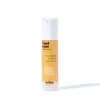What's inside
What's inside
 Key Ingredients
Key Ingredients

 Benefits
Benefits

 Concerns
Concerns

 Ingredients Side-by-side
Ingredients Side-by-side

Water
Skin ConditioningPropylene Glycol
HumectantEthoxydiglycol
HumectantNiacinamide
SmoothingPolyglyceryl-3 Methylglucose Distearate
EmulsifyingRosa Canina Fruit Oil
EmollientHippophae Rhamnoides Seed Oil
Skin ProtectingHippophae Rhamnoides Fruit Oil
Skin ProtectingPanthenol
Skin ConditioningDimethicone
EmollientGlycerin
HumectantSqualane
EmollientCetyl Alcohol
EmollientVaccinium Macrocarpon Seed Oil
Skin ConditioningTocopherol
AntioxidantCamellia Sinensis Leaf Extract
AntimicrobialCeramide NP
Skin ConditioningCeramide AP
Skin ConditioningCeramide EOP
Skin ConditioningPhytosphingosine
Skin ConditioningCholesterol
EmollientSodium Hyaluronate
HumectantSodium Lauroyl Lactylate
EmulsifyingCarbomer
Emulsion StabilisingXanthan Gum
EmulsifyingDiazolidinyl Urea
PreservativeMethylparaben
PreservativePropylparaben
PreservativeDisodium EDTA
Water, Propylene Glycol, Ethoxydiglycol, Niacinamide, Polyglyceryl-3 Methylglucose Distearate, Rosa Canina Fruit Oil, Hippophae Rhamnoides Seed Oil, Hippophae Rhamnoides Fruit Oil, Panthenol, Dimethicone, Glycerin, Squalane, Cetyl Alcohol, Vaccinium Macrocarpon Seed Oil, Tocopherol, Camellia Sinensis Leaf Extract, Ceramide NP, Ceramide AP, Ceramide EOP, Phytosphingosine, Cholesterol, Sodium Hyaluronate, Sodium Lauroyl Lactylate, Carbomer, Xanthan Gum, Diazolidinyl Urea, Methylparaben, Propylparaben, Disodium EDTA
Squalane
EmollientLinum Usitatissimum Seed Oil
PerfumingRosa Canina Seed Oil
EmollientLecithin
EmollientSalvia Hispanica Seed Oil
MoisturisingPunica Granatum Seed Oil
EmollientArgania Spinosa Kernel Oil
EmollientTocotrienols
Skin ConditioningTocopherol
AntioxidantAstaxanthin
Skin ConditioningLycopene
AntioxidantXanthophylls
Skin ConditioningThioctic Acid
AntioxidantBeta-Carotene
Skin ConditioningDocosahexaenoic Acid
Skin ConditioningCeramide NP
Skin ConditioningCholesteryl Oleyl Carbonate
Skin ConditioningCholesteryl Nonanoate
EmollientCholesteryl Chloride
Skin ConditioningBHT
AntioxidantPhytosterols
Skin ConditioningOryzanol
Skin ConditioningSqualane, Linum Usitatissimum Seed Oil, Rosa Canina Seed Oil, Lecithin, Salvia Hispanica Seed Oil, Punica Granatum Seed Oil, Argania Spinosa Kernel Oil, Tocotrienols, Tocopherol, Astaxanthin, Lycopene, Xanthophylls, Thioctic Acid, Beta-Carotene, Docosahexaenoic Acid, Ceramide NP, Cholesteryl Oleyl Carbonate, Cholesteryl Nonanoate, Cholesteryl Chloride, BHT, Phytosterols, Oryzanol
 Reviews
Reviews

Alternatives
Ingredients Explained
These ingredients are found in both products.
Ingredients higher up in an ingredient list are typically present in a larger amount.
Ceramide NP is a type of ceramide and formally known as ceramide 3.
Ceramides are intercellular lipids naturally found in our skin that bonds dead skin cells together to create a barrier. They are known for their ability to hold water and thus are a great ingredient for dry skin.
Ceramides are an important building block for our skin barrier. A stronger barrier helps the skin look more firm and hydrated. By bolstering the skin ceramides act as a barrier against irritating ingredients. This can help with inflammation as well.
If you would like to eat ceramides, sweet potatoes contain a small amount.
Read more about other common types of ceramides here:
Ceramide AP
Ceramide EOP
Squalane is an emollient that helps the skin hold onto moisture. It's an oily liquid that occurs naturally in certain types of fish and plant oils.
Because squalane boosts hydration in the skin, it also comes with plenty of benefits: it is an antioxidant and can help fight free radicals and skin damage. Squalane is also found to have a detoxifying effect when applied.
Squalane comes from squalene, which occurs naturally within the sebum of our skin. It is one of the oils our skin produces to keep itself hydrated. Squalane is the hydrogenated version of squalene and has a longer shelf life.
Research shows that squalane is non-irritating (even at 100% concentration).
In general, it's a fantastic ingredient. It does a great job at hydrating the skin, and it's suitable for those with sensitive skin.
The source of squalane may impact malassezia / fungal acne. This is because olive oil derived squalane can contain impurities such as fatty acids and plant waxes. Sugarcane derived squalane is recommended for anyone with malassezia concerns.
Is squalane vegan?
This depends on the source. Squalane can be derived from both plants and animals. Most squalane used in skincare comes from plants.
Please note: the source of squalane is only known if disclosed by the brand. We recommend reaching out to the brand if you have any questions about their squalane.
Read more about squalene with an "e".
Is squalane an oil?
Squalane is often called an oil, but it’s technically not; it’s a hydrocarbon, meaning it’s only made of carbon and hydrogen, unlike true oils which are triglycerides made of fatty acids and glycerol.
The term “oil-free” isn’t regulated, so companies can define it however they want. Some exclude all oils, while others just avoid mineral oil or comedogenic oils.
While some people avoid oils thinking they cause breakouts, the right kind of oil (or oil-like ingredient like squalane) can actually help balance and hydrate your skin. It’s worth testing out simple oils or squalane to see what works best for your skin.
Learn more about SqualaneTocopherol (also known as Vitamin E) is a common antioxidant used to help protect the skin from free-radicals and strengthen the skin barrier. It's also fat soluble - this means our skin is great at absorbing it.
Vitamin E also helps keep your natural skin lipids healthy. Your lipid skin barrier naturally consists of lipids, ceramides, and fatty acids. Vitamin E offers extra protection for your skin’s lipid barrier, keeping your skin healthy and nourished.
Another benefit is a bit of UV protection. Vitamin E helps reduce the damage caused by UVB rays. (It should not replace your sunscreen). Combining it with Vitamin C can decrease sunburned cells and hyperpigmentation after UV exposure.
You might have noticed Vitamin E + C often paired together. This is because it is great at stabilizing Vitamin C. Using the two together helps increase the effectiveness of both ingredients.
There are often claims that Vitamin E can reduce/prevent scarring, but these claims haven't been confirmed by scientific research.
Learn more about Tocopherol